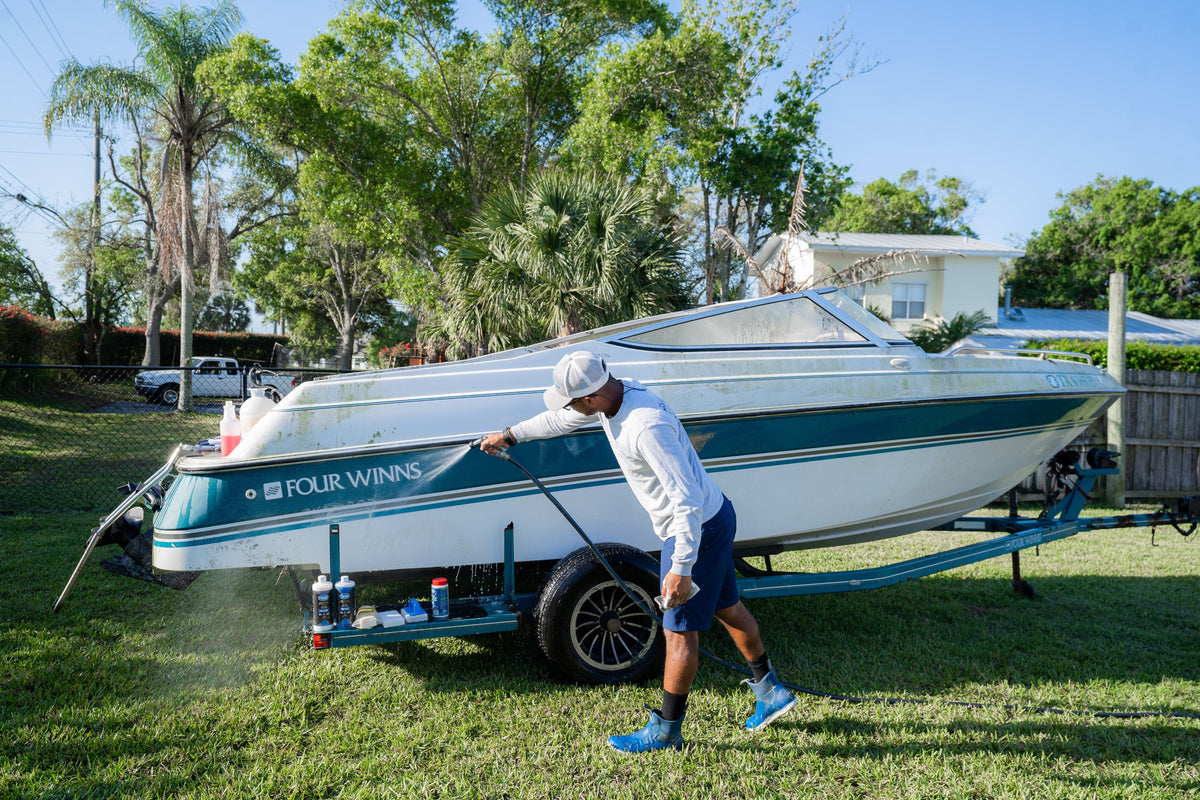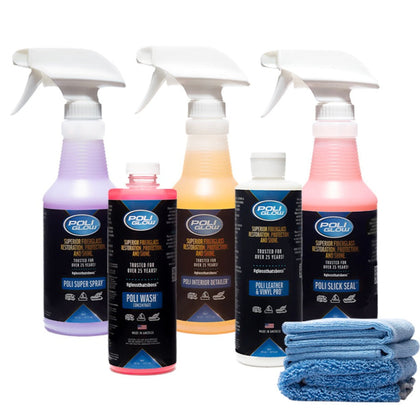
How To Wash a Boat
Time to read 7 min
Washing a boat might sound easy, but it’s not as simple as dumping some soap in a bucket. There are important nuances to washing boats properly you need to keep in mind if you want to keep your boat in “ship shape” (sorry, we had to).
Here are some tips on how to wash a fiberglass boat. Cheers to you for doing a little extra research before getting started!
Table of Contents
1. Why Boat Washing Is Important
3. A Step-by-Step Guide To Washing a Boat
6. How Poli Glow Products Can Help
7. How To Wash a Boat in 30 Seconds
Why Regular Boat Washing Is Important
Before we get to the how, let’s talk about the why. If you’re thinking “Because the boat’s dirty!”, you’re absolutely right. But it’s more than that.
Over time, boats and especially boat hulls are subjected to a lot of harsh and nasty things that compromise the surface, especially the gelcoat. These include:
- Saltwater
- Dirty fresh water
- UV radiation
- Heat
- Chemicals
- Oil and fuel
- Scum and grime
- Decomposing organic matter like bugs and leaves
- Barnacles
- Algae
The longer this material sits on the surfaces of your boat, the more time it has to penetrate, degrade, and stain.
So washing your boat regularly is not just about keeping it looking nice. Regular washing helps prevent damage that will require more complex and expensive repair and maintenance down the road.
And, let’s be honest…if you’re like us, busting out the hose, bucket, and boat soap on a sunny day is fun! So let’s get into it.
Preparing to Wash Your Boat
Washing your boat is a project. Depending on the size of your boat, it might be a large project. To do it right, you’re going to need some setup. Here are a few specific tips.
Pick the right location
In order to properly clean the hull, your boat will need to be out of the water and on a trailer. Make sure the trailer is on level ground and stable—concrete is ideal—with no chance of rolling or slipping. Make sure you have ample room on all sides of the boat to maneuver, and so that air can flow freely. If possible, avoid positioning the boat directly below trees, which could drop leaves and other debris onto the boat while you clean.
Pick the right weather
Check the weather forecast before you start cleaning. Sunshine and warmth are good. Rain and wind are not.
Pick the right cleaning products
Using the wrong cleaners in the wrong places can damage your boat. If your hull is fiberglass coated in gelcoat, opt for a pH-neutral, marine-specific cleaner. These are formulated to effectively remove dirt, salt, and grime without harming the gelcoat.
Since your boat will be used in nature, we recommend also choosing a cleaner that is biodegradable and will not harm the environment.
For the upper areas and interior of the boat, you’ll need two other products:
- An all-purpose detailer for glass, metal, plastic, and rubber surfaces.
- A conditioner for leather and vinyl surfaces, especially seats.

Pick the right tools
What’s most important about the tools you choose is to avoid ones that can scratch. Stains, marks, and oxidation may require stronger chemicals and abrasion to clean, but we’ll save that for later.
Microfiber towels and non-abrasive sponges are ideal. They can efficiently lift dirt without causing damage, and their high absorbency makes rinsing and drying more effective. If you prefer to use a brush, use a soft scrub brush with non-abrasive bristles to prevent scratches. A brush with telescopic handles can help with hard-to-reach areas.
Prepare and inspect your boat
Before you start, clear the boat of removable items, such as fishing equipment, cushions, coolers, and personal items. Put them in a safe, dry place. If your boat is equipped with delicate electronic systems, instruments, or fabric coverings like Bimini tops, you may want to protect them with appropriate covers or plastic sheeting. Secure any loose cables, ropes, or hoses on the boat.
Before you start washing, take a look at the hull, deck, and other surfaces. Make a mental note of damage or wear signs you want to come back and address.
A Step-by-Step Guide to Washing Your Boat
Okay, let’s start washing. For the purposes of these instructions, we’re going to use our high-foaming, biodegradable, pH-balanced boat cleanser Poli Wash™. If you are using a different product, the steps should be almost identical as long as it’s a marine-specific cleaner.
Instructions for washing the hull:
- Pour 1-2 ounces of Poli Wash™ into a 5-gallon bucket.
- Use the water pressure from your faucet or hose to create suds.
- Wash the surface of your boat with a soft cloth, like our microfiber Poli-Mitt™ Applicator, or a soft-bristled brush.
- Start from the top and work downwards, using circular motions. If you find a stain or mark that won’t come off don’t worry. We’ll deal with that in a bit.
- Rinse the hull thoroughly with fresh water. Do not allow the product to dry on the surface of your boat. Be especially aware of this on hot days when water evaporates quickly.
- You can let your boat air dry. Alternatively, if you want to avoid water spots, you can use a soft, absorbent chamois or microfiber towel to dry the boat (we love our plush 550 GSM Microfiber Towel). Start from the top and move downward.

Instructions for cleaning the deck and upper areas:
- Poli Wash™ is perfect for cleaning decks. Use the same instructions as above.
- For other surfaces you don’t want to get wet, you can use a waterless detailer like Poli Super Spray™. Poli Super Spray™ will also clean any glass on your boat.
- Don’t forget about the seats! Leather and vinyl surfaces like seats endure a lot of use and abuse. Over time, they can accumulate grime, sweat, sunscreen, dust, food and drink spills, salt, moisture, and UV radiation. All of this dries out the material and eventually leads to cracking and peeling. Use a special conditioner like Poli Leather & Vinyl Pro™ to restore and nourish the material and to keep it soft and supple.
How to Fix a Faded, Cloudy, Stained, or Oxidized Gelcoat
Let’s say you’ve washed your boat, but you’ve noticed that even once it’s clean, it doesn’t look as good as you’d like. Maybe the colors are faded. Maybe you found some stains, rust spots, or other blemishes that wouldn’t come off with the cleaner. There’s a way to fix this, and immediately after you wash your boat is the perfect time!
But first, you need to understand what’s going on. The culprit here is a process called “oxidation.” New fiberglass boats have a protective gelcoat that shields the fiberglass from the elements. Over time, heat, moisture, and UV radiation from the sun break down the compounds in your gelcoat.
As the gelcoat degrades, it becomes more porous. It develops that tell-tale chalky appearance. Dirt and grime are able to penetrate more easily which causes deeper staining. Colors fade. Mold and mildew begin to accumulate. This process destroys the glossy shine all new boats have and makes them appear increasingly old and worn.
In order to restore a shine and gloss to your boat, you’ll need to remove a small layer of the degraded gelcoat, and then seal it with something that will protect it from further degradation.
Should You Wax Your Boat?
The traditional solution to oxidation has been to polish and wax your boat. Polishing involves taking an electric buffer, and combining it with a compound that acts kind of like a liquid sandpaper. You then buff the entire hull of your boat. The buffer and compound remove a thin layer of the damaged gelcoat, exposing the healthy gelcoat underneath and making it shine.
After buffing and polishing the gelcoat, you cover it in boat wax to protect it. A newly polished gelcoat will start to degrade and oxidize until after about a year, at which point your boat will start to look old and faded again. The polished surface will last longer if you wax it every 3-4 months, but that’s a lot of upkeep, which is why you see so much dull, faded fiberglass in the marina.
When done properly, polishing and waxing can be an effective solution to gelcoat oxidation. However, most people don’t have the expertise to do it correctly, and the upkeep is burdensome, which often leads to disappointing results.
Here’s the other thing to consider: each round of buffing and polishing removes gelcoat material from the surface, which means you only have so many rounds of polishing before there is no gelcoat left.
How Poli Glow® Products Can Help
At Poli Glow®, we take a different approach. We’ve developed a boat restoration system that is an alternative to polishing and waxing.
Our Poli Prep™ and Poli Ox™ products help you remove oxidation, grime, and stains. They require no buffers to work, just a scratch pad and some elbow grease—which means they remove less of your gelcoat.
Once the oxidation is removed, you apply our flagship product Poli Glow®. Again no buffers needed—just wipe it on and let it dry.
Poli Glow® forms a smooth, hard, glossy surface that seals and protects the gelcoat underneath and gives it a “like new” shine again.
The Poli Glow® coating will last for up to six years with a few maintenance coats each year. Poli Glow® fights against oxidation which preserves the gelcoat. Poli Glow® repels water and prevents material from adhering to the gelcoat so stains don't develop. This makes it easier to wash!
All of these products can be found in our Poli Glow® Deluxe Kit, which has everything you need to remove oxidation and restore a boat’s shine and gloss.
How to Wash a Boat in 30 Seconds
In case you didn’t read all that, here’s the “Too long; didn’t read” for how to wash a boat:
- Proper washing is key to extending your boat’s life
- Pick the right weather and location to wash your boat
- Use a boat-specific, biodegradable, ph-balanced cleanser like Poli Wash™.
- Don’t use cleaning tools that will scratch your gelcoat.
- Don’t let the cleaning solution dry on your boat.
- Faded, chalky, or stained hulls are the result of a process affecting your gelcoat called “oxidation”.
- To restore shine and gloss, remove the oxidation and seal the gelcoat with a protective coating.
- You can do this by buffing, polishing and waxing your boat, or with Poli Glow®’s wipe-on polish alternative.
Watch Poli Glow® products restore a boat with heavy oxidation:






